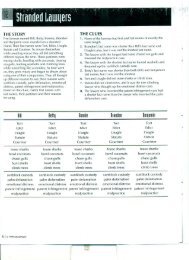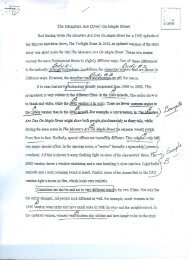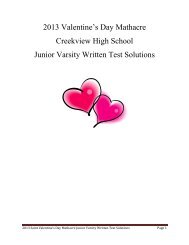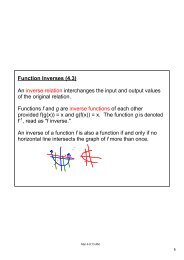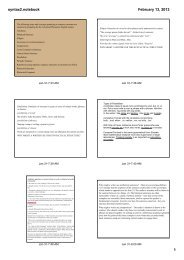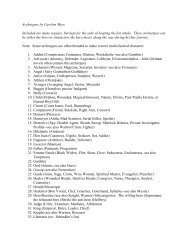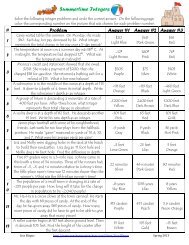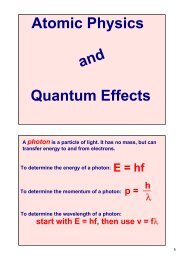Rosencrantz and Guildenstern Are Dead - Cherokee County Schools
Rosencrantz and Guildenstern Are Dead - Cherokee County Schools
Rosencrantz and Guildenstern Are Dead - Cherokee County Schools
Create successful ePaper yourself
Turn your PDF publications into a flip-book with our unique Google optimized e-Paper software.
one of their plays called for a hanging. As the Player understates it quite simply near the end of the play, "In<br />
our experience, most things end in death." They also underst<strong>and</strong> from their experience portraying death on<br />
stage that human beings believe more in the familiar illusion of mortality than they do the frightening<br />
actuality of it. When <strong>Guildenstern</strong> says,"You die so many times; how can you expect them to believe in your<br />
death," the Player responds, "on the contrary, it's the only kind they do believe. They're conditioned to it." He<br />
underst<strong>and</strong>s that given the human denial of their own mortality, fictive experiences are the only way to create<br />
"a thin beam of light that, seen at the right angle, can crack the shell of mortality."<br />
As it winds down to its conclusion, Stoppard's play focuses on this relationship between fictive death, real<br />
mortality, <strong>and</strong> the question of uncertainty. Early in the play the audience shares a feeling of uncertainty with<br />
<strong>Rosencrantz</strong> <strong>and</strong> <strong>Guildenstern</strong> when they are as much baffled by the results of the coin-tossing game, the<br />
eccentricities of the tragedians, <strong>and</strong> perhaps even by the rapid-fire Elizabethan verse of the Hamlet characters.<br />
During these periods of the play, the audience develops an empathy for the two heroes, identifying with their<br />
confusion <strong>and</strong> lack of certainty. But late in Act II, the tragedians present their version of The Murder of<br />
Gonzago <strong>and</strong> predict quite explicitly how <strong>Rosencrantz</strong> <strong>and</strong> <strong>Guildenstern</strong> will die: "a twist of fate <strong>and</strong> cunning<br />
has put into their h<strong>and</strong>s a letter that seals their deaths." At this point, even if they don't know the Hamlet story,<br />
the audience must accept the deaths of <strong>Rosencrantz</strong> <strong>and</strong> <strong>Guildenstern</strong>. But <strong>Rosencrantz</strong> "does not quite<br />
underst<strong>and</strong>'' what he has witnessed <strong>and</strong> finally says, "yes, I'm afraid you're quite wrong. You must have<br />
mistaken me for someone else." More aware but equally denying, <strong>Guildenstern</strong> simply gets angry <strong>and</strong><br />
challenges the Player: "you!— What do you know about death!" However, the audience is implicated in this<br />
denial as well, for it is a metaphor for their own refusal to accept the most certain thing in their lives. As the<br />
Player tells about his experience with the actor in his troupe actually hanged on stage during a performance,<br />
he paints a picture of an audience that could not accept real death in a place where they had become<br />
accustomed to fictive death—"audiences know what to expect, <strong>and</strong> that is all that they are prepared to believe<br />
in." From this point until the end of the play, Stoppard's audience is forced to watch fictive characters acting<br />
out the denial of their mortality. At the same time, the audience is invited to compare its own attitude toward<br />
the certainty of death with the one demonstrated by <strong>Rosencrantz</strong> <strong>and</strong> <strong>Guildenstern</strong>. When the play is over,<br />
they have witnessed yet another pair of fictive deaths <strong>and</strong> maybe have advanced ever so slightly toward being<br />
prepared for their own.<br />
Source: Terry Nienhuis, in an essay for Drama for Students, Gale, 1997<br />
Nienhuis is an associate professor of English at Western Carolina University<br />
Tom Stoppard's Lighted March<br />
At the top of his form, Tom Stoppard writes tragicomedies or comic ironies. Stoppard's top form has given us<br />
<strong>Rosencrantz</strong> <strong>and</strong> <strong>Guildenstern</strong> <strong>Are</strong> <strong>Dead</strong> (1967) <strong>and</strong> Arcadia (1993), contenders for the finest postwar<br />
English-language drama, <strong>and</strong> in neither case generic comedy, since comedy includes importantly a limited,<br />
socially satisfying resolution over <strong>and</strong> above the laughs. Because the recent brilliance of Arcadia happily<br />
implies that Stoppard may give us much more, I do not think of these two plays as bookends enclosing his<br />
life's work. At the same time, however, a close look will provide a useful awareness of Stoppard's dramatic<br />
structures <strong>and</strong> methods as well as of his preoccupations as a man of his century, his extraordinary sense of<br />
humor, <strong>and</strong> his commitment to the history of ideas as humanity's river.<br />
<strong>Rosencrantz</strong> <strong>and</strong> <strong>Guildenstern</strong> <strong>Are</strong> <strong>Dead</strong> (hereafter R&GAD ) gets a big <strong>and</strong> essential head start from the fact<br />
that Hamlet tends to be more or less a part of the cultural equipment of anyone reading or seeing R&GAD.<br />
Indeed, I can only suppose that Stoppard's play must be confusing or even incomprehensible to one who has<br />
not heard of the Shakespeare tragedy.<br />
Tom Stoppard's Lighted March 14





